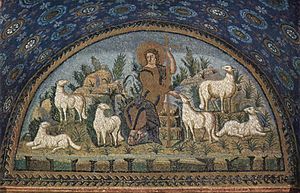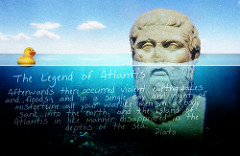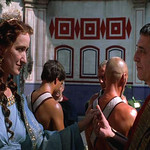This post is a sequel to Another Empty Tomb Tale.
The Gospel of John has the most sermonizing or serious philosophical tone to it with its many figurative speeches of Jesus. It is natural for anyone not familiar with the literary world in which it was produced to remain unaware that it also reflects many features of the popular love stories of its day. That is, in fact, the point of most interest to me: in order to really understand the nature of the gospels one must understand the literary culture in which they were created.
I recently posted an extract of an empty tomb scene from Chaereas and Callirhoe that can scarcely fail to remind a modern reader of the scenes surrounding the empty tomb in the gospels, particularly the Gospel of John. In the Chaereas and Callirhoe love novella the empty tomb scene appears early in the plot and is the gateway to the main action that follows.
Crucifixions
Continuing with the same Chariton novel, one finds that even an unjust crucifixion of a main character serves to add dramatic tension.
The hero (Chaereas) and his friend (Polycharmus) are falsely condemned as murderers and unjustly sentenced to crucifixion. The condemned are portrayed as carrying their own crosses to their doom. Chaereas’ nobility of character is demonstrated by his patient silence in the face of this injustice and suffering. (As in the earlier post, the extracts are from Reardon’s Collected Ancient Greek Novels.)
Some of the men in Chaereas’s chain gang . . . broke their chains in the night, murdered the overseer, and tried to escape. They failed . . . Without even seeing them or hearing their defense the master at once ordered the crucifixion of [all] the men . . . They were brought out chained together foot and neck, each carrying his cross — the men executing the sentence added this grim public spectacle to the inevitable punishment as an example to frighten the other prisoners. Now Chaereas said nothing when he was led off with the others, but Polycharmus, as he carried his cross, said: “Callirhoe, it is because of you that we are suffering like this! You are the cause of all our troubles!” . . .
Polycharmus is then whisked off to the governor who ordered the crucifixion, Mithridates, in the expectation that he can reveal more about names associated with the murder. In the course of the interrogation before the governor, Polycharmus said:
“. . . Now we put up with our misfortune patiently, but some of our fellow prisoners . . . broke their chains and committed a murder; and you ordered us all to be taken off and crucified. Well, my friend [Chaereas] didn’t utter a word against his wife, even when the execution was under way . . . . Sir, please tell the executioner not to separate even our crosses.”
This story was greeted with tears and groans, and Mithridates sent everybody off to reach Chaereas before he did. They found the rest nailed up on their crosses: Chaereas was just ascending his. So they shouted to them from far off. “Spare him!” cried some; others, “Come down!” or “Don’t hurt him!” or “Let him go!” So the executioner checked his gesture, and Chaereas climbed down from his cross . . .
Mithridates [the governor] met him and embraced him. “My brother, my friend!” he said, “Your silence almost misled me into committing a crime! Your self-control was quite out of place!” (pp. 67-69)
The silence of Jesus in a similar predicament is generally read as an astonishing holiness of character. So it is instructive to see the same motif applied to the hero of a popular novel from around the same era.
Other novels likewise contain scenes of miscarriages of justice and crucifixions of the hero, or apparent scenes of sure death of the heroine, and which turn out happily nonetheless.
Here is one more example. This is from another love story, An Ephesian Tale by Xenophon ‘of Ephesus’, translated by Graham Anderson.
When the prefect heard the particulars, he made no further effort to find out the facts but gave orders to have Habrocomes taken away and crucified. Habrocomes himself was dumbfounded at his miseries . . . The prefect’s agents brought him to the banks of the Nile, where there was a sheer drop overlooking the torrent. They set up the cross and attached him to it, tying his hands and feet tight with ropes; that is the way the Egyptians crucify. . . . But Habrocomes looked straight at the sun, then at the Nile channel, and prayed: “Kindest of the gods, ruler of Egypt, . . . if I, Habrocomes, have done anything wrong, may I perish miserably and incur an even greater penalty if there is one; but I have been betrayed . . . .” The god took pity on his prayer. A sudden gust of wind arose and struck the cross, sweeping away the subsoil on the cliff where it had been fixed. Habrocomes fell into the torrent and was swept away; the water did him no harm . . . . (p. 155)
Innocent heroes, betrayals, unjust judges, crucifixions, patient endurance, empty tombs, faith in the gods to deliver . . . . They are all as much the stuff of ancient popular fiction as they are of the canonical gospels.
The focus on the character, not the pain
Another interesting detail that the gospels and these novellas have in common is their focus on the nobility of character of the hero through his unjust treatment and crucifixion. A modern reader expects a portrayal of crucifixion to convey the physical agony involved, that that is something quite absent from both the ancient novels and the gospels. (Mel Gibson fulfilled an obvious modern demand for that sort of detail with his The Passion of the Christ movie.)
Other novelistic motifs
Jo-Ann A. Brant is one academic who has published studies in the novelistic motifs and art in the Gospel of John. I have discussed some of her work in some detail previously. Here I will just point to some of the main ideas that she explains. The following are extracts from my earlier post Novelistic plot and motifs in the Gospel of John.
Abandoned child
The true father of Jesus, God himself, chose to leave his infant son in the foster care of humble parents from Nazareth. By doing this he was knowingly leaving his son to become a victim of false accusations, envy, abuse and death. But his motive was entirely good — it was done out of love and not any desire to see his son die. All blame for mistreatment falls on those who carry it out, and the father bears no responsibility for what his son suffers.
That the hero or heroine was abandoned by their parents and left to face death, and raised by others of a very lowly status, was a common theme in ancient mythology and novels: . . . .
(See Novelistic plot . . . for more details)
Wanderings and signs
Novels would commonly begin with an opening conflict that led to a series of episodes in which the main character wandered from adventure to adventure, facing death, danger, conflict and temptation at every turn. The hero would also carry signs of their true parentage, and these signs would themselves often be the focus of the movement of the story. Some would be in awe of the signs (whether they were something about their physical appearance or tokens or some form of wealth) and want to protect the hero; others would be envious or greedy and want to kill them.
(See Novelistic plot . . . for more details)
The first love scene
Can’t have a good novel without good love scenes. The gospel of John plays with some of the standard ones.
“There is near consensus among literary critics that the scene at Jacob’s well follows conventions of the betrothal type-scene found in Hebrew narrative.” (Husband hunting, 211)
(See Novelistic plot . . . for more details)
The second love scene
At the commencement of the story of Lazarus the author informs readers that the Mary he is to refer to is the one who will later in the gospel anoint Jesus’ feet with perfume and her hair. Thus we are given a motive for Mary’s later act — she loves Jesus out of gratitude for raising her brother from the dead.
Then Mary took a pound of very costly oil of spikenard, anointed the feet of Jesus, and wiped his feet with her hair. And the house was filled with the fragrance of the oil. (12:3)
The reader knows that the woman is preparing Jesus for burial, but the actors in the narrative do not know this. Rather, the scene is heavy with sensuality, and suggestive of a prenuptial ritual. At the level of the textual narrative (apart from its symbolic meaning) it appears that Mary is attempting to court Jesus, even asking him to marry her.
(See Novelistic plot . . . for more details)
At the end the main character must reconcile his own desires with those of his father. Jesus does not wish to die but acknowledges that that is the reason the father has left him to face the world (12:27-28). His obedience to the father’s will ultimately confirms that he truly is the obedient son of God.
Similar motifs are at work in An Ethiopian Story: a trial at the end, a daughter who must prove her obedience to her father, a father who feels obliged to sacrifice his daughter for the sake of the people — although in this case the crowd calls out for her to be set free, contrary to the demands of the crowd in the gospel.
(See Novelistic plot . . . for more details)
Death and marriage, a popular couplet
In the opening miracle in the Gospel of John, there is again a strong association between marriage and death. The Cana miracle took place at a wedding, but the miracle itself, with its imagery of blood, pointed to the death of the bridegroom Jesus. Again in the Gospel of John we see the same ironic association when Jesus is anointed. The reader knows the sensual scene, one that ostensibly borders on a proposal of marriage, is in fact (and unknown to the characters involved) a preparation for the death of Jesus.
The metaphoric link between marriage consummation and an untimely death is common enough. Another example of it in ancient novels from the cultural era of the gospels is the second century novel by Achilles Tatius, Leucippe and Clitophon:
And when will you marry, my son; when will I make the offerings to sanctify your wedding, O groom and bridegroom — unconsummated bridegroom, unlucky chevalier. Your bridal chamber is the grave, your wedlock is with death, your wedding march a funeral hymn, your marriage song this dirge. (p. 186)
What a resplendent wedding: your bedroom is a prisoners’ cell; your mattress is the ground; your garlands and bracelets are hawsers and wrist ropes; the bride’s escort is a brigand sleeping at the door! Instead of the wedding march we hear a funeral song. (p. 214)
(From Reardon’s Collected Ancient Greek Novels)
Like this:
Like Loading...








